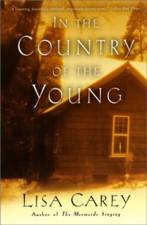

| . | ||
| Click on a book's image or title to order from Amazon.com |

In the Country of the Young
Perennial, TPB, © 2000, 286 pp, ISBN #0-06-093774-2Reviewed August 2002
In 1848, a ship bringing immigrants from Ireland escaping the potato famine crashes off the coast of Maine, and the survivors end up on a small island later named Tiranogue. But one young girl, Aisling, passes away shortly after rescue. A century and a half later, a middle-aged man named Oisin MacDara lives alone on Tiranogue, emotionally isolated from the people around him. Once able to see the dead, he lost that gift when his twin sister Nieve died when they were teenagers. He's waited his adult life for her to come back, but instead it's Aisling to manifests as a real girl one November morning.
In the Country of the Young is a story told in three interleaving parts: Aisling's childhood as the illegitimate daughter of a lower-class woman in Ireland, ostracized by everyone except her beloved brother Darragh. Oisin and Nieve's years as the children of a couple who don't love each other, in 1960s and 70s Boston. And Oison and Aisling's story in the present day, as they adjust to living together and what they have to gain from knowing each other.
Although at times painfully melancholy, Country is fundamentally a story about the living: Oisin has been spiritually dead all these years, and he has to learn what he has to live for without his sister. Aisling has been actually dead, and has returned to have the experience of growing up (as, indeed, Oisin is, in a sense).
Despite its short length, there is a huge amount of imagery in the story - too much, perhaps, as such details as Oisin's printmaking skills at times verge on the tedious. It's the characters and their situations which make the book truly rewarding. Although I found Oisin's childhood difficult to relate to (his adolescent experiences are too far removed from my own, especially his early sexual experiences), his story is more compelling than Aisling's, with his parents' tense relationship, their relationship with his father's family in Ireland, and the tragedy extending through both lines of the family. Carey follows a cardinal rule of characterization, that no one is a villain in their own mind, and the sometimes infuriating actions of some of Oisin's family are made clear and understandable, albeit no less tragic.
The present-day story is one of life and growth, as I said, with all of the arguments and pain and frustration and anticipation and joy that that implies. Oisin's nearby friend Dierdre, her son, and her nieces add some color and complexity to Oisin and Aisling's relationship; both play crucial roles as foils for the main characters, but in different ways as the story progresses and Aisling - rather unexpectedly - grows up. Again Carey proves deft at illuminating her characters and their changes, but gradually and subtly so you're barely aware that it's going on.
Although I spent the early part of the book wondering about the whys and hows of Aisling's return, Carey finesses the issue through the use of metaphor and character, and I was won over mid-way through. The book comes to a satisfying conclusion, and is only marred by its epilogue, which adds a downbeat note to what could otherwise have been a pleasant ending despite some bittersweet elements to its climax. The book is perhaps best read by skipping the epilogue entirely, and I dearly wish Carey chosen a different coda to her tale.
Nonetheless, In the Country of the Young is an enchanting and compelling read, even if - like me - you're not generally one for fantasy novels.
hits since 12 August 2002.